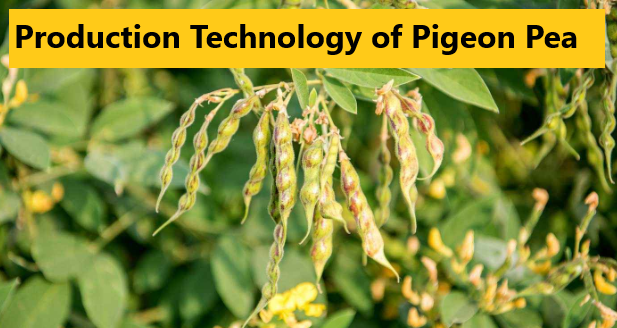How to Grow Pigeon Peas
English Name: Pigeon Pea.
Botanical Name: Cajanus cajan syn. Cajanus indicus.
Family: Fabaceae.
Importance of Pigeon Pea
The pigeon pea is a perennial legume. Its seeds have become a common food grain in Asia, Africa, and Latin America. It is consumed on a large scale mainly in south Asia and is a major source of protein for the population of that subcontinent. In Bangladesh, Pigeon Pea is more popular as Arhar. In regions where it grows, fresh young pods are eaten as a vegetable. Split pigeon peas are one of the most popular pulses, being an important source of protein in a mostly vegetarian diet.
Varieties of Pigeon Pea
Some Indian varieties are ICPL87, GT101, BDN2, ICPH 2740, Vaishali, GT9 etc.
Climate for Pigeon Pea production
Pigeon pea grows well in warm tropical and subtropical climate. The crop prefers a fairly moist and warm climate during the period of its vegetative growth during the flowering and repining stages of its growth, its requires bright sunny weather for the setting of fruits. It is highly susceptible to frost at the time of flowering. Cloudy weather and excessive rainfall at flowering time damage the crop to great extent.
• 30 – 35°C during germination.
• Slightly lower temperature (20 25°C) during active vegetative growth.
• During flowering and pod setting it requires 15-18°C temperature and at maturity it needs higher temperature of around 35-40°C.
• Arhar crop requires average rainfall of 600-650 mm with moist conditions for the first eight weeks and drier conditions during flowering and pod development stage, this will result in highly successful crop.
Soil for Pigeon Pea cultivation
Pigeon Pea may be grown well, on a wide range of soils varying from sandy loam to clay loam. It does best on fertile and well drained loamy soils. The saline-alkaline and waterlogged soil unfit for its cultivation. It grows well in well drainage red clay loam soil too. It can be grown successfully on neutral soils having a pH range of 6.5 to 7.5.
Land Preparation for Pigeon Pea cultivation
Pigeon pea being a deep rooted crop responds well to proper tilth. So land is prepared by at least one ploughing during the dry season followed by 2 or 3 harrowings and disc ploughing.
Seed Rate
The seed rate is 15 kg/ha.
Seed TreatmentTreat the seeds with Carbendazim or Thiram @ 2 g/kg of seed 24 hours before sowing (or) with powder formulation of Trichoderma viride @ 4g/kg of seed (or) Pseudomonas fluorescens @ 10 g/kg seed.
Spacing
♣ Rainfed condition: Row to Row: 90120 cm.
Plant to plant: 30 cm.
♣ Irrigated Condition: Row to Row: 5075 cm.
Plant to plant: 1520 cm.
Planting Time of Pigeon Pea
Pigeon pea is a traditionally Kharif crop sown in June – July.
Manuring
15 kg N and 45 kg P2O5 per hectare is sufficient for this crop.
Intercultural Operation Two weeding and hoeing are essential for the crop. Once about 2530 days and another about 4550 days after sowing the crop.
Irrigation Irrigation may be done at presowing stage and in absence of rains at flowering and pod development stage.
Disease and Pest of Pigeon Pea
▲ Major Diseases are Wilt, Phytopthora blight.
Wilt:seed treatment with Carbendazim + Thiram or Carbendazim @ 2g/kg seed. Inter cropping of Pigeon pea with sorghum.
Phytophthorablight: Ridge sowing and good drainage. Avoid sowing of pigeon pea in low lying fields. Seed treatment with Metalaxy1 @ 4 g/kg seed. Foliar spray of Metalaxy1 + Mancozeb (0.3%) in standing crop to minimize the disease.
▲ Main insect pest are Pod Fly, Pod Bug and Pod borer.
Pod fly and pod bug: Spraying Dimethoate 0.03%.
PodborerComplex: Spraying Dimethoate 0.03% or Fenvalerate 0.02% or Monocrotophos 0.04% or cypermethrin 0.004%.
Harvesting of Pigeon Pea
Maturity symptoms
In pigeon pea Farming, Green pigeon pea pods are harvested for different purposes. Fully developed, bright green seed is preferred for use as a vegetable. Hence, pods should be harvested just before they start loosing their green color. For this normally hand picking is followed. Pigeon pea leaves, unlike other crops remain green when the pods are ready for harvest. Pigeon pea should be harvested when 7580% of the pods turn brown and are dry. Delayed harvesting, during badweather, may increase the risk of damage to mature seed.
Methods
Traditionally pigeon pea plants are harvested by cutting the stem at the base with a sickle, but occasionally machines are used for cutting and followed by drying and threshing.
Threshing
The harvested plants are bundled and placed upright to dry for a week depending on the weather conditions. Pods and grain are separated by beating the dry plants with sticks or by using a thresher. In some places by cattle trampling seeds are separated.
Storing of Pigeon Pea
Pigeon pea is usually stored for long periods to ensure availability of whole seed at the time of sowing, and as a dhal to meet consumer requirement.
Yield of Pigeon Pea
ICPH 2740 variety yield is 3 ton/ha.
Useful Agricultural Websites
